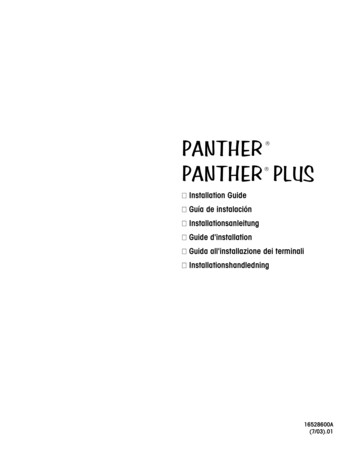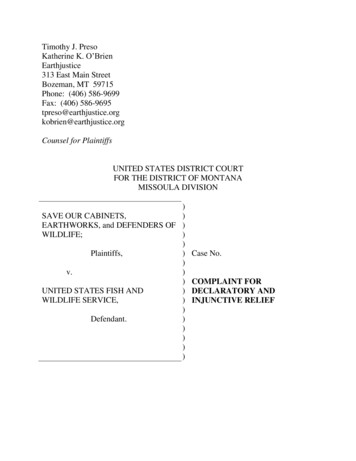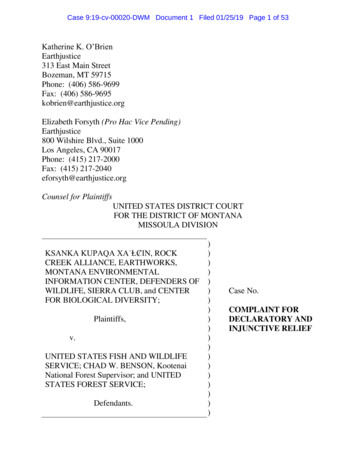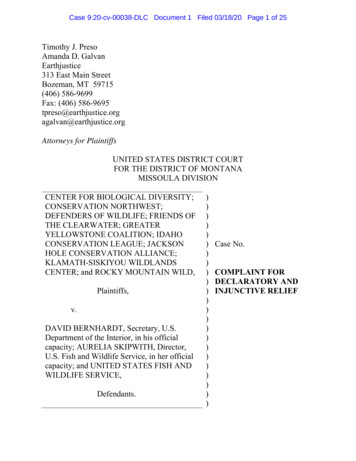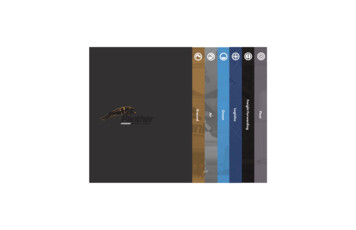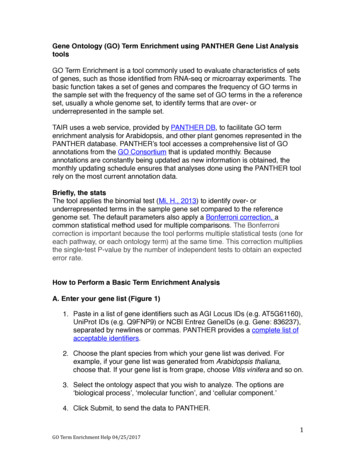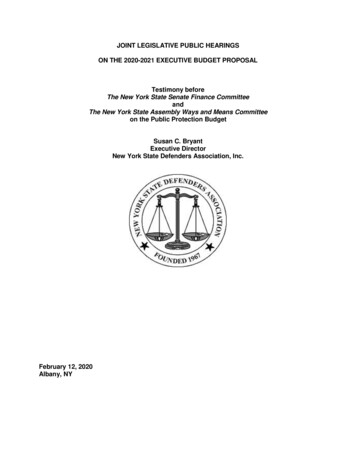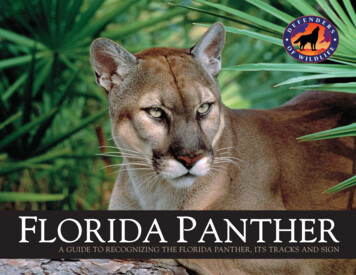
Transcription
F LORIDA P ANTHERA GUIDE TO RECOGNIZING THE FLORIDA PANTHER, ITS TRACKS AND SIGN
Florida Panther:Past and PresentThe Florida panther (Puma concolor coryi) is federally protected as a subspecies of Puma (Pumaconcolor) that once ranged throughout North America (Figures 1 and 2). Pumas are known bymany names – puma, cougar, mountain lion, painter, catamount and panther. The Florida pantherrepresents the only known breeding population of puma in the eastern part of the country. Nearlyextirpated by early settlers from its historic range spanning much of the Southeast, the panther hasFigure 1. Habitat loss and fragmentation are the main threats tobeenrestricted to less than 5% of its former range. Only a single breeding population now survives inthe Florida panther.the southern tip of Florida (Figure 3). While most Florida panthers reside south of Lake Okeechobee,several males have traveled northward into central and northeast Florida, and one even dispersed to central Georgia near the Alabama border. And forWKH ¿UVW WLPH VLQFH WKH HDUO\ V IHPDOH SDQWKHUV KDYH EHJXQ WR FURVV WKH &DORRVDKDWFKHH 5LYHU DQG EUHHG LQ VRXWK FHQWUDO )ORULGD JLYLQJ QHZ KRSH for range expansion.:KLOH PDQ\ EHOLHYHG WKH )ORUGLD SDQWKHU ZDV H[WLQFW WKH SUHVHQFH RI D VPDOO SRSXODWLRQ ZDV FRQ¿UPHG LQ VRXWK )ORULGD LQ WKH V 6XEVHTXHQW UHVHDUFK PRQLWRULQJ DQG KDELWDW FRQVHUYDWLRQ HIIRUWV KDYH KHOSHG WKH VSHFLHV LQFUHDVH LQ QXPEHU DQG RYHUDOO KHDOWK 5HFRYHU\ DFWLRQV RYHU WKH ODVW IRXU GHFDGHV SDUWLFXODUO\ JHQHWLF UHVWRUDWLRQ LQLWLDWHG LQ WR VDYH WKH )ORULGD SDQWKHU IURP H[WLQFWLRQ KDYH HQDEOHG WKH SRSXODWLRQ WR JURZ IURP D ORZ RI WR LQ WKH HDUO\ V WR DQ XSSHU ERXQG RI DSSUR[LPDWHO\ DGXOW DQG VXEDGXOW SDQWKHUV LQ VRXWK )ORULGD E\ 'XULQJ WKLV VDPH SHULRG )ORULGD¶V KXPDQ SRSXODWLRQ JUHZ IURP DERXW PLOOLRQ WR RYHU PLOOLRQ people. The Florida panther remains threatened with extinction — its greatest threat today beingdevelopment and fragmentation of its habitat.Because of increases in numbers of both people and panthers, urban and suburban areas now interfaceZLWK SDQWKHU KDELWDW H[SDQGLQJ WKH SRVVLELOLW\ RI KXPDQ SDQWKHU LQWHUDFWLRQV 6LQFH SDQWKHU HQFRXQWHUV KDYH EHFRPH PRUH IUHTXHQW LQ VRXWK )ORULGD LQFOXGLQJ LQVWDQFHV RI SDQWKHUV SUH\LQJ upon livestock or pets. To address this situation,Figure 2. A Florida panther has long legs and a long tail.the U.S. Fish and Wildlife Service (USFWS),National Park Service (NPS) and Florida FishDQG :LOGOLIH &RQVHUYDWLRQ &RPPLVVLRQ ):& implemented a Florida Panther Response Plan toprovide guidance on consistent handling of inter actions while promoting public safety and recog nizing the need to recover an endangered species.Defenders works with landowners and agenciesRQ FRQÀLFW DYRLGDQFH SURJUDPV DQG SURGXFHG WKLV guide to assist the public in identifying and under standing panthers and other wildlife in Florida.1Figure 3. The Florida panther, which once ranged throughout much ofthe southeastern United States, has been pushed into a fraction of itshistoric range by past persecution and today’s unchecked development.The panther used to occur as part of a contiguous population of pumaacross North America.
Figure 4. The Florida panther is a solitary animal and prefers to inhabit wilderness areas away from people and development.Introduction to Identifying PanthersThe Florida panther has a tawny brown back and pale gray underside (Figure 4). Males measure nearly seven feet long from nose to the tip of thetail. While males may exceed 150 pounds, they weigh an average 120 to 130 pounds and stand 23 to 27 inches high at the shoulder. Females aresmaller, reaching a length of about six feet and weighing 70 to 75 pounds. Kittens are born with dark spots that fade away as they become adults (Figure5). Throughout this guide, the word “puma” is used to describe photo images of pumas or puma sign unless the puma is a Florida panther.Figure 5. Spotted furhelps to camouflagevulnerable pantherkittens from predators.Figure 6. Skull characteristicshave been used to differentiatethe Florida panther from otherpuma populations in NorthAmerica. The panther skull isrelatively broad and flatwith highly arched nasalbones, giving the face aroman-nosed appearance.2Western PumaFlorida Panther
Animals CommonlyMisidentified as PanthersMany animals are mistaken for Florida panthers, espe cially in low light or at a distance. Although reportedpanther sightings are numerous, investigations reveal thatPRVW VLJKWLQJV DUH PLVLGHQWL¿FDWLRQV RI RWKHU DQLPDOV VXFK as deer, domestic dogs, coyotes, foxes, bobcats, bears orother species. Sightings of “black panthers” are commonlyreported; however, a melanistic (black) puma has never beenFRQ¿UPHG LQ )ORULGD RU DQ\ZKHUH HOVH ZLWKLQ LWV ODUJH JHR graphic range across the Americas. Other cat species, such asbobcats, jaguars and leopards, do have dark color phases thatRFFXU PRUH IUHTXHQWO\ LQ GHQVHO\ IRUHVWHG KDELWDWV 1Figure 7. An adult Florida panther has a long tail;its inner legs and belly are pale and without spotsand its ears are rounded.Figure 8. A Florida bobcat has a shorter tail withdark rings around it, spots on its belly and legs, andpointed ears with white patches on the back. Mostwill have tiny black ear tufts on the tip of each ear,bars and stripes that accent the face and mouth anda ruff of fur encircling the head.1. Bobcat Jennifer Benoit 5HG IR[ 6XVDQ & 0RUVH3. Florida black bear David S. Maehr %REFDW GULQNLQJ RXW RI ELUGEDWK Karen King5. Bobcat peeking through grass 6XVDQ & 0RUVH :KLWH WDLOHG GHHU 0DUN /RW] LQIUD UHG PRWLRQ VHQVLWLYH WUDLO FDPHUD ):& 'RPHVWLF FDW DQG EREFDW Jennifer Benoit &R\RWH 'DYLG 6KLQGOH LQIUD UHG PRWLRQ VHQVLWLYH WUDLO FDPHUD ):& %REFDW O\LQJ GRZQ Arline Erdrich5 &R\RWH 6XVDQ & 0RUVH11. Bobcat at night &DURO\Q %ULJKW12. Bobcat in yard Jennifer Benoit13. Golden retriever Shawn Olson3
23 6 8111213
Panther TracksJust as a human hand has five fingers, a panther’s front foot has five toes, but only four register in its track impression: the toe corresponding to the human thumb does not register. Look for four teardrop-shaped toe prints, asymmetrically arranged just like thefour fingers on your hand: a leading toe corresponding to your middle finger; and a little toe, which, like your little finger, is physicallysmaller than the other three digits, and is on the outside of the paw (Figure 9).Depending on the softnessor hardness of the ground,the robust fleshy middlepad appears blunt and flattopped or bi-lobed like an“m.” (The middle pad isoften mistakenly called“heel pad.”) Three relatively even lobes align alongthe bottom of the middlepad impression, whichmeasures 1 ¾” – 2 ½” (seepage 9). The middle pad isthe dominant feature of thetrack – the opposite of allcanines, whose middle padis smaller (Figure 19).In contrast to the symmetrical tracks of all canids, youcannot draw an “X” througha panther track due to cats’asymmetrical toe arrangement and middle pad’sblunt or bi-lobed front edge(see Figure 19 for comparison).Typically, claw impressions are not seen in panther tracks. Panthers’ retractable claws are kept sheathed within fleshy pockets positioned above the toes. On rare occasions, claw marks will show in a track if the animal is running, jumping or negotiating a slipperysurface. They appear in front of the toe impression as tiny sharp holes or slits.5
leading toelittle toetri-lobedmiddle padFigure 10. The puma’s left front foot has five toes, but only fourregister in the track. One is high on the foot and is not visible in this photo.A hind foot has four toes. Usually the front foot’s track will appear larger,broader and more asymmetrical than the hind foot track.Figure 11.Florida panthertracks, right feet.(h) hind(F) FrontFigure 12. Florida panthertrack. Note that some tracks(like this one) will not show theasymmetrical toe arrangementof the “middle finger” toeleading and the “little toe”trailing because the hind footstepped directly into the frontfoot track impression andslightly altered its originalappearance. Look at lots oftracks in order to gather themost accurate information.6
Comparison of Pantherand Bobcat TracksAbobcat’s (Lynx rufus) tracks resemble a panther’s, but they are muchsmaller (Figure 16). Not even a panther kitten old enough to walk withits mother has a track as small as a bobcat’s; there is no size overlap. A panther kitten small enough to leave a bobcat-sized track is an infant and will becarried in its mother’s mouth instead (Figure 13).Figure 13. A mother puma carries her infant kitten in her mouth.leading toeThe condition of the tracking substrate (soft mud, clay, sand or hardpacked gravel road) can dramatically influence your measurementsand will often exaggerate the size of an animal’s track (Figure 15). Checkmultiple tracks in a variety of terrain, then closely examine an averagesized track and look for the right physical characteristics and appropriatemeasurement ranges to accurately identify your animal. For example, ifit is a bobcat the overall track impression will be the size of a golf ball, incontrast to the tennis ball- or baseball-sized impressions of large femaleor male panthers. Bobcat toe pads are teardrop-shaped and pea- to beansized; panthers’ teardrop-shaped toe impressions are penny- to quartersized, depending on the sex and size of the panther and on the substratein which the track was made. Bobcat middle pads range from 1” – 1 ¼”wide; adult panthers range from 1 ¾” – 2 ½ ” wide (Figure 14 and Figure16). Study the following information in order to appreciate how othermeasurements will allow you to further differentiate between panther andother species.little toeFigure 14. Bobcat right frontfoot. Note the presence ofall physical features found inpanther tracks. Susan C. Morse
Figure 16.Relative sizesof feline tracks:It is helpfulwhen examininga potential panthertrack to recall therelative sizes of theother cats whosetracks can befound in Florida.HousecatBobcatRight foot track. Note little toe is on the outside of the track.Figure 15. Bobcat track next to turkey track.PumaFigure 17. Many peoplesee Florida’s morecommon native cat, thebobcat, andmistake it for a panther.8
Florida Panther Tracking MeasurementsFigure 18. If a panther is moving slowly, the hindfoot impression will register behind the front foot.Normal walking usually appears as a direct registeredor double registered track. A faster-walking pantherwill leave tracks with hind foot impressions in front ofthe forefoot impressions.Middle pad width1 ¾” – 2 ½”Track height (not including claw impression)3” – 3 ¾”Overall track width2” – 3 ¼”True stride measurement25” – 40”Next step measurement15” – 32”Straddle width (depending on speed and gait)(Figure 18)7” – 11”Canid Tracks (including coyotes, foxes and dogs)In canids, four large toes are symmetrically arranged in paired forward and rear toes. Most often theblunt nail impressions register; however, sometimes they do not. All toes are roughly the same sizeand they dominate the track, appearing collectively larger than the middle pad impression.The inside edges of the two rear toes come to a point (Figure 22). Panther toes are teardrop shaped.You can readily trace an “X” through this symmetrical arrangement of toe and middle pad impressions of fox, dog and coyote (Figure 19). This feature often persists in old tracks even after otherclues disappear. Red fox toes and middle pads are much smaller than those of a coyote or dog andare largely obscured by abundant foot fur (Figure 20). The red fox is probably not native to Florida.A canid’s middle pad impression is pointed, like the pointed face of a dog.The bottom edge of the middle pad appears as an uneven chevron-shaped arrangement of two thinner, lower, outer lobes, encircling a more robust center lobe situated higher on the track.Thicker, blunt nail impressions of canids usually appear in their tracks, typically extending directlyforward from the toe impressions. Gray fox nails appear more catlike, delicately inserting pin prickholes in front of the toe prints. Be aware that dogs, wild or domestic, with worn nails or thick callused pads sometimes leave tracks with no nail marks (Figure 21).
Figure 19. Coyote track.Note the symmetrical arrangement of forward andrear toes, the pointed middlepad and the X that can bedrawn through the track.Figure 20. Red foxtoes and pads leavemuch smallerimpressions thancoyote and dog feet.They will appearmuffled withabundant foot fur.Figure 21.Bobcat left frontand hind tracks areon the left, gray foxtracks are on theupper right.hFFigure 22. Femalepanther tracks to theleft, dog tracks to theright. Note the “X” anddistinctive claw marksin the dog tracks. Insideedge of rear toes cometo a point. Squared off edge.Rear toes come to a point
Bear TracksThe Florida black bear (Ursus americanus floridanus), a unique subspecies of the American black bear, is found in scattered populations around thestate, including within the panther’s range. Occasionally a bear front foot track impression may fool you into thinking you’ve found a “huge panthertrack,” but panther tracks are small by comparison. Measure the middle pad carefully; if it’s 1 ¾” to 2 ½” wide, it identifies a panther. Furthermore, eachbear track should register all five toes at some point (unlike panther tracks). Middle pad impressions of bear feet are broad and not at all shaped likethe tri-lobed panther pad. Note that the bear has a big toe on the outside of its paw (Figure 23) granting increased stability to this heavy-bodied animal.A panther’s track shows the little toe on the outside - corresponding to a human hand’s little finger (Figure 9).FRONT RIGHT FOOT“big toe”on outsideFigure 23. Florida black bearfront right track. One cansometimes add a little water toenhance the features of a trackthat appears obscure.11
Figure 24. Florida black bear tracks. Note that the “big toe” is on the outsideof both tracks indicating that you are looking at left feet. The knife is pointingat nail impressions. Test yourself: seek to understand why the front track cannot possibly be a panther track.left rear“big toe”on outsideh“big toe”Figure 25. The Florida black bear inhabits wild areas in south Florida alongwith the panther. Bears and panthers seek cover in saw palmetto and otherunderstory vegetation.Figure 26. Reported sightings of Florida panthers are often of large animals atnight. As a result, Florida panthers have even been confused with black bears.left frontf“big toe”1213
Panther ScatDepending on the prey or specific prey portions eaten, a panther’s scat (fecal matter) may appear as a soft,blackish cord of pure meat or organ meat waste material 1 ¼” to 1 ½” thick. It may have no obvious identifiable remains in it. If the diet includes more prey hair and bones, the cords become more constricted and may bebroken into blunt or round-ended segments (Figure 27). Panther scats sometimes are conspicuously placed on topof a scrape for added olfactory (scent-marking) information (Figures 28 and 29). Deer, hog or raccoon hair may berecognizable in panther scat. Old scats, which originally consisted of meat waste products, will turn whitish grayas they dry out and age.Figure 28.Florida pantherscrape.Scent MarkingScent marking involves an animal’s deposition of chemical signals throughout the habitat. Animals scent markFigure 27. Panther scats are most oftenwith urine, feces, glandular secretions, saliva and othersegmented with round or blunt-endedbodily substances. It is not only olfactory but also visual,sections. One can carefully inspect theenabling wide-ranging, potentially competing members ofdroppings for the bones and hair of preyspecies. Handling a scat without glovesspecies like panthers to position themselves temporally andcan infect one with hookworms!spatially within their habitat. The advantages are twofold:marking transmits scent messages to other panthers, facilitating mutual avoidance and preventing unwanted encounters and fighting. Marking odorantsare also a vital “bulletin board” for panthers, announcing their social and reproductive status topotential breeding partners. Unlike bobcats and house cats, pumas (panthers) are not known tospray urine as part of their scent-marking repertoire.A scratch or scrape is the most frequently found panther scent-marking sign (Figures 28 and 29).The panther’s hind feet push back dirt, pine needles, and other soft materials into a slight mound,upon which the animal sometimes urinates and/or defecates. The most consistent scent messagesfound within the scrape are odorants deposited from interdigital glands that are located betweenthe toes of a panther’s foot. A shallow, rectangular trough 8 to 12 inches wide ends in a small pile;this constitutes long-lasting and ubiquitous sign of panthers wherever they are in residence. Lookfor scrapes/scratches under big pine trees, at intersections of trails or all-terrain vehicle roads, oralong the edge of an ecotone (transition area between two adjacent plant community or habitattypes). A pungent tomcat odor can sometimes be detected on a fresh scrape.13Figure 29.Puma scrapemade inabsorbentpine needles.
Claw RakingClaw raking trees and logs by panthers does occur; however, this sign is often very subtle and can only be reliably documented in conjunction with other irrefutable sign:e.g. tracks, a den site or a cached prey animal. Biologists researching Florida panthers notethat claw raking on horizontal logs, especially fallen cabbage palm, is much more commonlydetected than panther raking on standing trees (Figure 33). Unlike black bear scent marking on trees (Figure 30), panther claw scratches are most often repeated, with two areas ofscratching evident–correspondingto the grasping panther’s forearms and paws working the log ortree trunk in unison (Figures 31and 32). Bear “mark trees” showevidence of the bear’s thickerclaw scars, corresponding to theirblunter nails. Florida bear markingsign is often accompanied by bitemarks and black hairs left behind,as the bear rubbed its body on themarked surface.-Figure 31. Claw raking of logs and trees shreds the object being“marked,” making it visually conspicuous. The “message” is conveyedthrough secretions from glands between the toes that are absorbed by thefrayed wood.
Figure 34. Puma clawraking sign on a tree.Notice sharper, finerscratches indicativeof a feline’s sharper,finer claw structures.Figure 32.Puma scentmarking a tree.Figure 33.Sign of Florida pantherclaw raking isapparent onthis log.15
Prey RemainsExtreme caution should be used when examining a prey cache (hiddenprey remains). The owner of the cache might be watching from nearbycover and seek to defend this hard-won meal.Investigators should not inspect remains unless in the company of a wildlifeagency official (e.g. Florida Fish and Wildlife Conservation Commission,U.S. Fish and Wildlife Service). A preliminary examination using binoculars from a safe distance may reveal some clues.After feeding, the panther caches its prey animal intact (Figures 35 and 36). Coyotes and bears will sooner or later tear the carcass apart while feeding. Canidscache their prey in pieces, whereas panthers feed upon and bury the entire carcassin one place. Also, panthers may use their incisors to shear hair from their prey,thus the prey animal’s hair will be found neatly clipped in regular sized “hair hanks”(Figure 37). Dirt, leaves, pine needles and hair hanks are visible on and around the cached prey. Although bobcats are also known to kill and cache deer(especially in northern habitats), it is difficult to drag their heavy prey to conceal it under dense cover. In the company of qualified researchers, youmay determine the predator’s identity by measuring the width of prey hair hanks, the canine tooth diameter and dental spacing of the predator’s biteand by examining the style of kill. Panthers will most often kill deer-sized preywith a killing bite to the throat or nape of the neck. Other carnivores’ kills oftenexhibit multiple bite wounds to the face and rump area. Another thing tolook for is the appearance of the prey animal. If its legs are extended, it wasmost likely killed by a predator. If the victim’s legs are positioned beneathitself, then the animal most likely died in a bedded position, possibly of amortal injury, extreme parasitism, malnutrition or disease. Often predatorsget blamed for killing such animals when in reality they only scavenged theremains of an already deceased animal.CFigure 35. Puma caching its deer prey.anid-killed prey are usually shredded in the rear/hamstring/hock areaand also on the ears. They are sometimes covered with hair hanks;however, the clumps of clipped hair are irregular and variable in size. Thehanks are often attached to pieces of hide that were torn off while the prey’smeat was exposed and consumed. Remember, most wild canids are socialanimals that rarely eat alone; they are apt to be extremely competitive andaggressive with each other. Fighting over the right to eat invariably resultsin torn-apart prey, with pieces scattered about, and disturbed surroundings.
Caution: Always be extremely careful not to harm or change thetracks or sign as this will destroy the usefulness of the evidenceEffective Tools and Field Practicesfor Recording Sightings andPreserving SignWhenever possible, tracks and sign should be photographed next to a ruler, such as theKeeping Track KTM ruler that can be opened at right angles to illustrate the length andwidth of the subject being photographed. A digital camera is recommended so you canimmediately check the quality of your photo documentation. Take multiple photos of multiple tracks and sign if possible; this increases your chance of a positive identification.After taking several photos, you may make a plaster cast of the track. We recommendplacing a frame around the track so that the track environment can be cast with a thickerplaster bed that will be more durable.Collect any feces found at the site. Feces may be stored in a paper or plastic bag for a fewhours or frozen in a plastic bag. The material should be turned in to authorities as soon aspossible to preserve its value as evidence.Preserving the tracks or sign for inspection by a wildlife expert or to be photographed isalso a valuable option. Simply placing a heavy waterproof box or bucket with a weight ontop protects a track or scat from the elements.If you discover the remains of a deceased panther, take photos and contact the FloridaFish and Wildlife Conservation Commission. If the panther was killed by another pantherevidence of bite wounds on the skull may be observed (Figure 38).It is best if all observers present agree on how to describe and document tracks or sign, aswell as identifying the entire site location before recording information. Consensus amongall participants allows for a more objective investigation to proceed. Practice scientificrigor in the field; the evidence at hand should solidly support your report. Reporting SightingsIf you would like information onverifying or reporting panthersightings, call Defenders of Wildlifeat 727-823-3888. To report aninjured or dead panther (such asan animal hit by a vehicle) contactthe Florida Fish and WildlifeConservationCommissionat1-888-404-3922 or #FWC or *FWCon cell. Text to: TIP@myfwc.comFigure 38. Panthermales sometimes killother panthers infights over territory,a natural phenomenonthat may increase as thecats seek out habitat inFlorida’s diminishingwild lands. Note howthe teeth of one skull fitinto the bite wounds ofthe victim’s skull.
If You Live In or Visit Panther Country.Landscape for safety. Remove dense or low-lying vegetationthat provides hiding places for panthers and other predators nearyour house. Choose plants that do not attract deer or other panther prey. For information on plants that deer do not like to eat,visit http://edis.ifas.ufl.edu/UW137. Appropriate fencing willmake your yard or play area uninviting to prey animalssuch as deer.Be alert from dusk until dawn (and whenever deer are active).Florida panthers are primarily active at night. Be aware of yoursurroundings and supervise children when outdoors in pantherhabitat.Keep panther prey away. Deer, raccoons, rabbits, armadillosand feral hogs are prey for the Florida panther. By feeding deeror other wildlife, people inadvertently may attract panthers. Donot leave potential wildlife food outside, such as unsecured garbage or pet food. Consider fencing fruit and vegetable gardens.Consider other deterrents. Outdoor lighting, motion sensorsand electric fencing may deter prey animals and panthers fromentering your yard and make approaching prey and panthersmore visible to you.Keep pets safe. Free-roaming, tethered or unfenced pets are easyprey for predators, including panthers. It is also illegal to let petsroam in Collier, Lee and many other counties. Bring pets insideor keep them in a secure, enclosed kennel at night. Feedingpets outside can attract raccoons and other panther prey; do notleave uneaten pet food available to wildlife.Drive safely. Obey speed limits and reduce your speed in wildlifeareas. Be extra alert during dawn, dusk and at night.Don’t litter. Human food attracts wildlife and litter thrown froma car attracts wildlife to roadsides.Keep domestic livestock secure. Place chickens, goats, sheep,hogs or other livestock in enclosed structures at night. Plansfor building predator-proof enclosures for pets or livestock areavailable at www.mountainlion.org. Electric fencing can bean effective predator deterrent. Defenders of Wildlife providesadvice and assistance for the building of enclosures and otherdeterrents. See tional information available at:Defenders of Wildlife www.defenders.orgFlorida Fish and Wildlife Conservation Commissionwww.myfwc.com/panther/U.S. Fish and Wildlife Service South Florida EcologicalServices Office www.fws.gov/verobeachKeeping Track www.keepingtrack.orgMountain Lion Foundation www.mountainlion.org18
Help Protect The Florida PantherLearn more about the Florida panther at www.defenders.org.Share information with family, friends and neighbors.Support efforts to protect Florida’s natural areas throughpublic land acquisition, private land conservation easementsand sound land management that conserves and restoresnatural systems.Get involved in road and highway planning affecting yourcommunity. -planning.Support endangered species programs and laws, such as thefederal Endangered Species Act, that save and recover speciesat risk and the habitat they depend upon.Order a “Protect the Panther” or “Conserve Wildlife” licenseplate for your car. A portion of the proceeds from these platesgoes to panther research and other wildlife conservation efforts.See www.myfwc.com/panther.Want to help the Florida Fish and Wildlife ConservationCommission monitor panthers? Share your panther photos atmyfwc.com/panthersightings.Find us on Facebook at Defenders of Wildlife/FloridaJoin Defenders of Wildlife at www.defenders.org. Sign up foralerts and updates at http://action.defenders.org.About Defenders of WildlifeDefenders of Wildlife is a national, nonprofit membership organization dedicated tothe protection of all native wild animals and plants in their natural communities.Florida Office433 Central AvenueSuite 208St. Petersburg, FL 33701727-823-3888efleming@defenders.orgNational Headquarters1130 17th Street, NWWashington, DC 20036202-682-9400www.defenders.orgThis guide was made possible throughgenerous funding provided by theFreed Foundation.Project Director: Elizabeth FlemingTechnical writing and most photography Susan C. MorseCover photograph Lynn M. StoneDesign: MooseMarx Design, Inc. 2018 Defenders of WildlifeSuggested citation: Morse, Susan C. 2018.Florida Panther: A Guide to Recognizing the FloridaPanther, Its Tracks and Sign. Defenders of Wildlife,St. Petersburg, Florida. 18pp
The Florida panther is a solitary animal and prefers to inhabit wilderness areas away from people and development. T he Florida panther has a tawny brown back and pale gray underside (Figure 4). Males measure nearly seven feet long from nose to the tip of the tail. While males may exceed 150 pounds, they weigh an average 120 to 130 pounds and .
